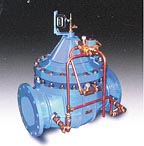
The resulting pressure wave is transmitted throughout the system, subjecting every component in the system to pressures approaching 10 times the normal system pressure. The pressure returns to normal only when it is dissipated by friction loss, pipe expansion or when something gives - a valve or section of pipe. Let's take a closer look at the causes of water hammer and consider some remedies.
For water hammer to occur four conditions must be present - sufficient flow velocity, an abrupt change in velocity, a sufficiently long pipe run and a rigid piping system. Regarding flow velocity, it generally is agreed that water flow velocities below 5 feet per second (fps) preclude the possibility of water hammer. The abrupt change in velocity can either be rapid acceleration (pump start/valve opening) or it can be rapid deceleration (pump stop/valve closure).
This first formula below is used to calculate the critical time factor, the velocity change time frame below which water hammer occurs, based on the length of the pipe run. The second formula offers a means for calculating the maximum pressure surge resulting from water hammer in a rigid piping system.
The formula used to calculate the critical time factor, which is the minimum time duration for a valve to open or close or for a pump to start or stop without causing water hammer, is as follows:
Critical time factor in seconds:
Tc = 2L/S
Where: L = Length of pipe in feet
S = Speed of sound in water (4,860 fps)
For example, if we have a 400-foot pipe run from the well to the house, the critical time factor would be:
Tc = 2 x 400/4,860
Tc = 0.16 seconds
This means as long as the pump takes less than 0.16 seconds to start, or if a valve in the house is closed in less than 0.16 seconds, your pressure tank better be in good working order. If it is waterlogged, you may have a water hammer every time the pump starts or a valve is closed.
What, then, would be the worst-case peak pressure caused from water hammer? The Instrument Society of America suggests the following formula for a rigid piping system based on the assumption that the shock wave will travel at the speed of sound, which is 4,860 fps for water. Of course, no piping system is absolutely rigid, so the actual peak pressure would be a little less than these numbers.

Where: Ps = Maximum pressure surge in PSIG
Po = Normal system operating pressure in PSIG
V = Velocity of fluid in fps
SG = Specific gravity of fluid (1 for water)
Let's assume a 30/50 pressure switch, 20 gpm in 1-inch schedule 80 pipe. The velocity of 20 gpm in 1-inch Schedule 80 pipe would be about 7.5 fps. This information is in the pressure loss charts available from most pipe and pump manufacturers. Therefore, the maximum pressure surge would be:
Ps = 50 + (64 x 7.5 X 1) = 537.5 PSIG
Now that we know how to calculate the severity of the water hammer problem, how can we protect our system? Start with a good system design. Size the piping such that the velocity does not exceed 5 fps. In the above example, if 11⁄4-inch pipe had been used instead of 1-inch, the velocity at 20 gpm would have been on the order of 4 fps vs. 7.5 fps and water hammer would not have been an issue. Also, make sure the pressure tank is checked regularly and at the first sign of air loss, fix the problem or replace the tank. Make sure there is not a check valve between the house and the pressure tank. You want any shock waves generated in the house to expand into the pressure tank and a check valve would prevent that from happening. The check valve needs to be between the pressure tank and the pump.
Consider using a flow control valve to reduce the peak flow velocity to below 5 fps. Consider installing a standpipe or small surge tank near the source of the water hammer. Consider replacing 1⁄4-turn ball valves with gate valves that open more slowly, or train the ball valve users to open and close them slowly.
In larger systems, pilot-operated flow and pressure control valves (Figure 1) can control the speed at which the velocity changes, be it on the pump end or in the distribution system. Electronic soft starts and variable speed drives (Figure 2) are another good solution to water hammer caused by pumps because they can be programmed to slowly ramp up and ramp down the pump speed.
Whether it is a small residential water system or large commercial piping system, water hammer can be a major problem. With an understanding of the factors contributing to the problem and access to the necessary tools, it is possible to tame this insidious gremlin and provide your customer with a quiet, long-lasting pumped water system.
'Til next time ….
ND


Report Abusive Comment